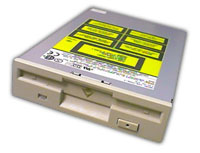Copyright
1996-2025
by TSW
(Nikolay Tuzhilin)
Last updated: 22.01.2025
The following notes were written in the 1999 year:
The first model of LS120 I bought many years ago when I need to transfer significant amounts of data (3-40M) between two sites. Plain floppy diskettes was not very suitable for such task as you first need to split file then write them on many diskettes and hope that the last will read on destination computer. I have to note that on that date CD-RW drives cost greater then 400$ and 20-30$ for each CD-RW disk. Alternative to CD-RW was magneto-optical disks but they also cost much but was of course incompatible with plain diskettes. So in LS120 drive I found at first the instrument that solved my problems. It cost not much and allowed to use plain diskettes saving space in case. But ...
 When
I have bought one more LS-120 drive for a computer at work, I did not expect to
receive something new. But in the price list there was model with letters "x2".
What does it may mean, I though. Is it twice as faster as old, I guess. But is
seems like true! Take a look at table below to compare two generations of LS-120
drives. Also "x2" model is more reliable at reading damaged diskettes as super
as usual. It is very good as "x1" models were able to lock your computer at many
dozens minutes when meet bad sector!
When
I have bought one more LS-120 drive for a computer at work, I did not expect to
receive something new. But in the price list there was model with letters "x2".
What does it may mean, I though. Is it twice as faster as old, I guess. But is
seems like true! Take a look at table below to compare two generations of LS-120
drives. Also "x2" model is more reliable at reading damaged diskettes as super
as usual. It is very good as "x1" models were able to lock your computer at many
dozens minutes when meet bad sector!
After some years of extensive using of both models I do not recommend you use LS120 at all if you are able to use CD-RW drive. Some years ago LS120 was cheaper then CD-RW technology but the later now has almost the same price but much more cost/performance effective. LS120 requires the special disk which are not became cheaper with time and also do not live more then 2-3 years which is very annoying - they die hard.
If you by some reasons do not want use CD-RW I recommend x2 model (do not use x1 in any case!). It will allow you to write about 120M of data very fast on one small disk and also to speed up and more reliable read plain floppy diskettes. When extensive use of LS120 better use Windows NT/2000 operation system as it allows you to simultaneously access LS120 and do other task, but Windows 9x will lock all activity unless read/write process is completed.
More recent updates (2005):
After many years of exploitation of this drive, I can say that I used it very rarely and always only to read/write old plain 1.44M diskettes, which as it seems still actual media to transfer some Word documents. So LS120 turned out to be dead end of evolution.
Installed together with the new hardware and run on the new operation systems (Windows XP), I found some configurations which conflict with this drive (very long time of disk recognition, disk error messages, periodical computer stalls for a second, etc.). The most stable configuration on my system is when LS120 drive connected as slave at the same cable as CDROM.
| Matsushita LS-120 drive Technical Specifications | ||
| Model # | LKM-F934-1(x2) | LKM-F734-1 |
| Version No. |
Version 5 |
Version 4 |
| Specification Mode |
UHD (120MB Mode) |
|
| Drive Interface |
IDE / ATAPI |
|
| Read/ Write Capacity (Per Diskette) |
120MB |
|
| Drive Rotation |
1440RPM |
720RPM |
| Latency Average |
20.8ms |
41.67ms |
| Transfer Rate Diskette to buffer | 10.88 Mbits/sec (max) | 5.44 Mbits/sec (max) |
| Transfer Rate Buffer to Interface | 11.1MB/sec (PIO mode) 13.3 MB/sec (DMA mode) |
8.3MB/sec (max) |
| Typical Sustained Transfer Rate (Across ATAPI Interface) | 531-958KB/sec Typical | 313-565KB/sec Typical |
|
120MB Physical Format Bytes / Sector Sectors / Diskette KB / Track MB / Surface Recording Density (BPI) Cylinders |
|
|
| Average Access Seek Time (including setting) |
86ms (Typical) |
112ms (Typical) |
| Track-to-Track Seek Time | 10ms (Typical) | 20ms (One Cycle seek, Typical) |
| Random Seek | 65ms (Typical) | 70ms (Typical) |
| Reliability MTBF |
15,000POH @25% duty |
|
| Hard Error Rate in UHD, HD, DD modes |
< 1 error per 10E12 bits |
|
|
Physical Dimensions W x H x D Weight |
|
|